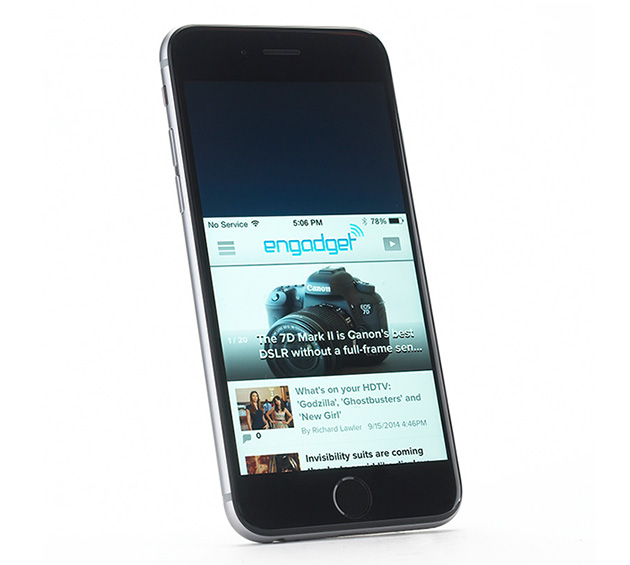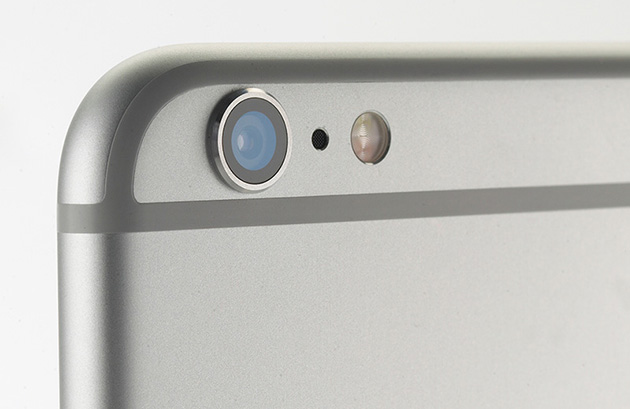iPhone 6 Plus
To say that Apple's doing things differently would be an understatement. With the 4.7-inch iPhone 6 and the 5.5-inch iPhone 6 Plus, the company introduced two new high-end phones at the same time, both with a complete redesign and a much larger screen size than any iPhone that came before. Gone are the days of 3.5-inch and 4-inch phones that, at one time, seemed to provide more than ample amounts of screen space. Now, the new iPhones make their predecessors look like the tiny handset Ben Stiller used in Zoolander. The market has changed, and it was high time Apple did the same.
Even though this is Apple's first attempt at building large phones, it's not breaking new ground -- in fact, it feels more like the company is catching up than innovating. To be fair, finding a fresh take is a difficult thing to do in this crowded space: Samsung's Galaxy Note series, which started out at 5.3 inches and is now up to 5.7, is selling by the millions, and most competing flagships aren't much smaller. Basically, Apple would be leaving money on the table if it didn't address this segment of the market. So how did the company do on its first try at large phones? Pretty well -- mostly.
Pros :
- Sleek new design
- Great display
- Comfortable to hold
- Fast performance
- Generally good camera
Cons :
- Battery life could be better
- Lacks optical image stabilization
- NFC can only be used for mobile payments
Summary
Even with a slightly larger screen, the iPhone remains comfortable to hold. With fast performance, a great display, an elegant new design and a much-needed software update, it's one of the best smartphones you can buy right now. We wish it had the same long battery life as the iPhone 6 Plus (not to mention its optical image stabilization) but even then, the iPhone 6 is still the better choice for most people.
Hardware
Aside from the screen size and a few minor hardware differences, the iPhone 6 and 6 Plus are identical. Unlike Apple's last four flagships (the 4 to the 5s), which sported a squarish, blocky shape, the 6 series features soft, rounded sides. Not counting the glass screen, the entire frame is constructed of aluminum, similar to the material Apple uses on its MacBooks.
As you'll see in my iOS 8 review, Apple's following a design approach centered on "continuity" -- the idea that its products should work seamlessly with each other. This is evident in the iPhone 6's hardware as well. The 5 and 5s had straight sides that met the front and back via chamfered edges. On the 6, Apple opted for a unibody build; the bubbled-out sides and flat back are constructed from one continuous piece of material. Meanwhile, the front glass panel tapers down ever so slightly at the edge, producing an uninterrupted look. I'll always have a soft spot for the chamfered edges on the 5 and 5s, but the 6 and 6 Plus feel fresh, especially after years of only modest design tweaks.
Software :
Both iPhones come preloaded with iOS 8. You can find my in-depth review of the update here, so I won't go into much detail in this review. But there are a few specific software features on the 6 and 6 Plus worth revisiting. Apple is treating the Plus as a small iPad mini (mini iPad mini?) of sorts: The springboard now can switch into landscape mode, and a few of the native apps (Mail, Calendar and Messages) come with dual-pane windows. This is a great use of the extra screen space, and it gives the Plus a clear productivity advantage over the 6.
While I'm on the subject of landscape mode, the keyboard also looks rather different. The standard keyboard shows up directly in the middle and is flanked by heaps of symbols and other options. Arrows and many of the popular punctuation marks are on the right, while options like copy and paste, undo and voice dictation are on the left.

Both iPhones also feature Display Zoom, which magnifies the screen and makes your icons, text and other materials larger. There's one-handed mode, which Apple refers to as "Reachability." This is technically available on both the iPhone 6 and 6 Plus, but it makes the most sense on the larger model. Since it's tough to stretch your tiny fingers all the way to the top of the screen, Apple's solution is to bring the screen down to you. When you double-tap on the Touch ID button, the entire UI slides down so the top half of the app is located on the bottom half of the screen. You can scroll and interact with it just like you normally could in full-screen mode, but in case you need to get to a link at the bottom of a website, or you're trying to get down to the end of an email, you'll have to go back out to see the entire screen. It's better than having no one-handed mode at all, but it still feels cumbersome and I only really used it when I wasn't able to use two hands (e.g., when I'm walking down the street while holding a bag).
It may sound like the Plus isn't ideal, and indeed, it's not for everyone. But for many, the additional screen real estate is worth sacrificing some one-handed comfort. Not only do you get more rows of icons on each screen (the 5s is 6 x 4, while the 6 is 7 x 4 and the 6 Plus is 7 x 4 with slightly larger icons and more space in between), but you're also going to be able to see more emails, tweets, Google search results, Engadget posts, calendar appointments and, well... more of everything. More screen space equates to more room for consuming, creating and manipulating content, and since it's still small enough to fit in most jeans pockets (provided they're not too tight), it's still more portable than any iPad.
Camera

While the megapixel war rages on among manufacturers like Sony, Samsung, LG and Microsoft Devices (Nokia), Apple doesn't seem to feel compelled to join the fray. Instead, it's sticking with a modest 8MP iSight camera similar to the one found n the 5s. Although the aperture and pixel size haven't changed, Apple's added "Focus Pixels," which is the company's fancy term for Phase Detection Autofocus (PDAF). The tech is used in many DSLRs and phones like the Galaxy S5, and the idea is to lock autofocus faster. Fortunately, Focus Pixels doesn't disappoint; in several side-by-side shots in which my goal was to snap a photo as quickly as possible, the 6 and 6 Plus did considerably better at producing focused images.
In case you need extra perks for going with the larger device, the Plus comes with Optical Image Stabilization (OIS). This feature is designed to reduce the amount of blur that can come from the natural shaking of your hand, and it produces better low-light performance as a result. I took several nighttime shots with the 6 and 6 Plus side by side, and although there was no difference in how much light the cameras took in, the images from the Plus consistently came out sharper -- both when viewing at standard size and especially when zoomed in.I also pitted the Plus head to head against several other flagships. It bested the HTC One M8 in sharpness and white balance, though it didn't get quite as much light; it had more natural colors and less noise than the LG G3; it got more light, better colors and clearer focus than the Galaxy S5; and although the Lumia 1020 brought in the most light, it also did so at the expense of unnatural colors and noise.






0 التعليقات :
إرسال تعليق